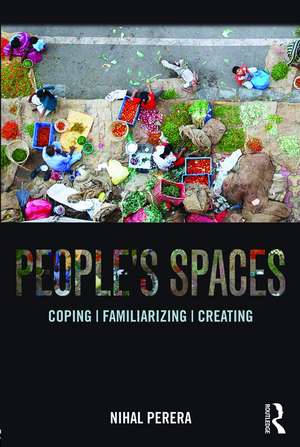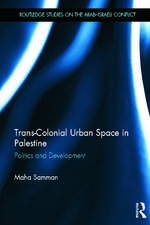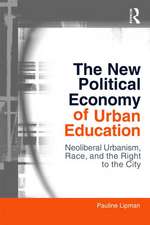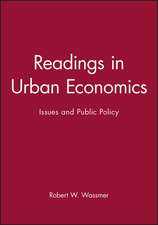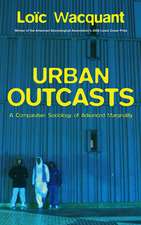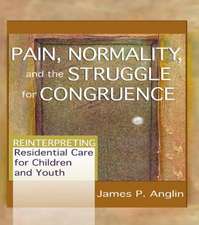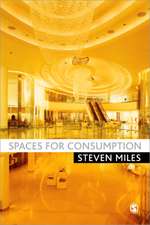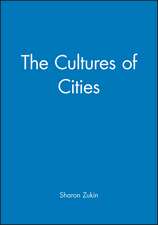People's Spaces: Coping, Familiarizing, Creating
Autor Nihal Pereraen Limba Engleză Paperback – 11 noi 2015
Current literature on cities and planning often looks at popular resistance to institutional authority through open, mass-movement protest. These views overlook the fact that subaltern classes are not often afforded the luxury of open, organized political protest. People’s Spaces investigates individual’s diverse approaches in reconciling the difference between their spatial needs and spatial availability. Through case studies in Southeast Asia, India, Nepal, and Central Asia, the book explores how people accommodate their spatial needs for everyday activities and cultural practices within a larger abstract spatial context produced by the power-holders.
| Toate formatele și edițiile | Preț | Express |
|---|---|---|
| Paperback (1) | 490.40 lei 6-8 săpt. | |
| Taylor & Francis – 11 noi 2015 | 490.40 lei 6-8 săpt. | |
| Hardback (1) | 1276.49 lei 6-8 săpt. | |
| Taylor & Francis – 2 noi 2015 | 1276.49 lei 6-8 săpt. |
Preț: 490.40 lei
Nou
Puncte Express: 736
Preț estimativ în valută:
93.85€ • 97.86$ • 77.100£
93.85€ • 97.86$ • 77.100£
Carte tipărită la comandă
Livrare economică 21 martie-04 aprilie
Preluare comenzi: 021 569.72.76
Specificații
ISBN-13: 9780415720298
ISBN-10: 041572029X
Pagini: 260
Ilustrații: 1 black & white tables, 43 black & white halftones, 8 black & white line drawings
Dimensiuni: 156 x 234 x 18 mm
Greutate: 0.48 kg
Ediția:1
Editura: Taylor & Francis
Colecția Routledge
Locul publicării:Oxford, United Kingdom
ISBN-10: 041572029X
Pagini: 260
Ilustrații: 1 black & white tables, 43 black & white halftones, 8 black & white line drawings
Dimensiuni: 156 x 234 x 18 mm
Greutate: 0.48 kg
Ediția:1
Editura: Taylor & Francis
Colecția Routledge
Locul publicării:Oxford, United Kingdom
Public țintă
PostgraduateCuprins
Introduction: Seeing and Acknowledging People’s Spaces: Deprivations and Challenges 1. Indigenizing the Colonial City: The Ceylonese Transformation of 19th-Century Colombo 2. Feminizing the White-Male City: Women Gaining Access to Colonial Colombo 3. Spaces of Survival: People’s Adaptation of a War Zone in Sri Lanka 4. From Resistance to Familiarization: Living in the World Heritage Site at Galle Fort (with Sanjeewani Habarakada) 5. Beginning Spaces: Young People’s Struggles for Dwellings in Tashkent (with Hikoyat Salimova) 6. Spaces of Recovery: Rebuilding Lives after the Tsunami in Kalametiya 7. Defending the Habitat: Redevelopment, Illegibility, and the Strength of Dharavi 8. Spaces of Modernity: Daanchi between Vernacular and Modern - (with Gaurab Kc) 9. Everyday Building: The Production of the Middle-Class Environment in Gangtok (with Sweata Pradhan) 10. People’s Neighborhood Center: The Handiya in Sri Lanka (with Nirmani Liyanage) Conclusions: Production of Social Space: From Coping with Extant Spaces to Creating Their Own
Recenzii
"That the making of urban space and life is largely located in the systematic, impetuous, and equivocal efforts of the majority of a city’s inhabitants, and which persist in spite of the impositions and destructions of both well-known and unfamiliar forces, remains an interminable reality and conundrum. For the ordinary contributions of this majority are undervalued to the extent of being rendered invisible or irrelevant. But by offering a sweeping historical account across varied Asian contexts and circumstances—particularly that of his war-torn homeland-- Perera restores the breadth of the creation, adjustments and intersections at work in how such contributions confront all kinds of disasters, dispossessions and potentials as a vital common sense. There is no book I know that so clearly renders apparently shrinking horizons into testaments of uneasy endurance." - AbdouMaliq Simone, Research Professor, Max Planck Institute for the Study of Religious and Ethnic Diversity
"Advocating for ‘grounded, bottom-up, community-based’ approaches to planning is meaningless without knowledge of how ‘lived spaces’ are created. The main objective of People’s Spaces is, therefore, to illustrate how people, through ‘coping, familiarizing, and creating’, transform abstract spaces into lived spaces even in the most constrained environments and restrictive regulatory frameworks. People’s Spaces is about homes, neighbourhoods and communities; the social relations that define them, and the particular socio-cultural meanings that people attach to them." - Asha L Abeyasekera, Faculty of Graduate Studies, University of Colombo, Sri Lanka
"Advocating for ‘grounded, bottom-up, community-based’ approaches to planning is meaningless without knowledge of how ‘lived spaces’ are created. The main objective of People’s Spaces is, therefore, to illustrate how people, through ‘coping, familiarizing, and creating’, transform abstract spaces into lived spaces even in the most constrained environments and restrictive regulatory frameworks. People’s Spaces is about homes, neighbourhoods and communities; the social relations that define them, and the particular socio-cultural meanings that people attach to them." - Asha L Abeyasekera, Faculty of Graduate Studies, University of Colombo, Sri Lanka
Descriere
People’s Spaces attempts to understand the struggle between people and institutions in the spaces they make by investigating individual’s diverse approaches in reconciling the difference between their spatial needs and spatial availability.
